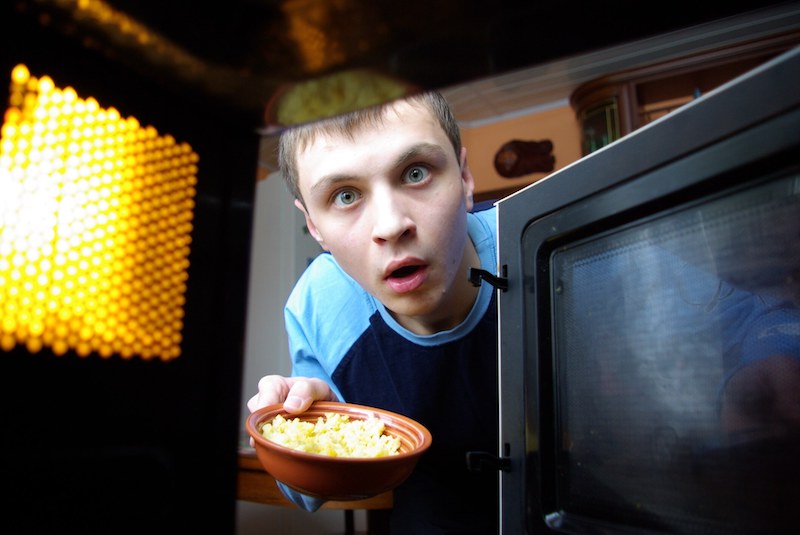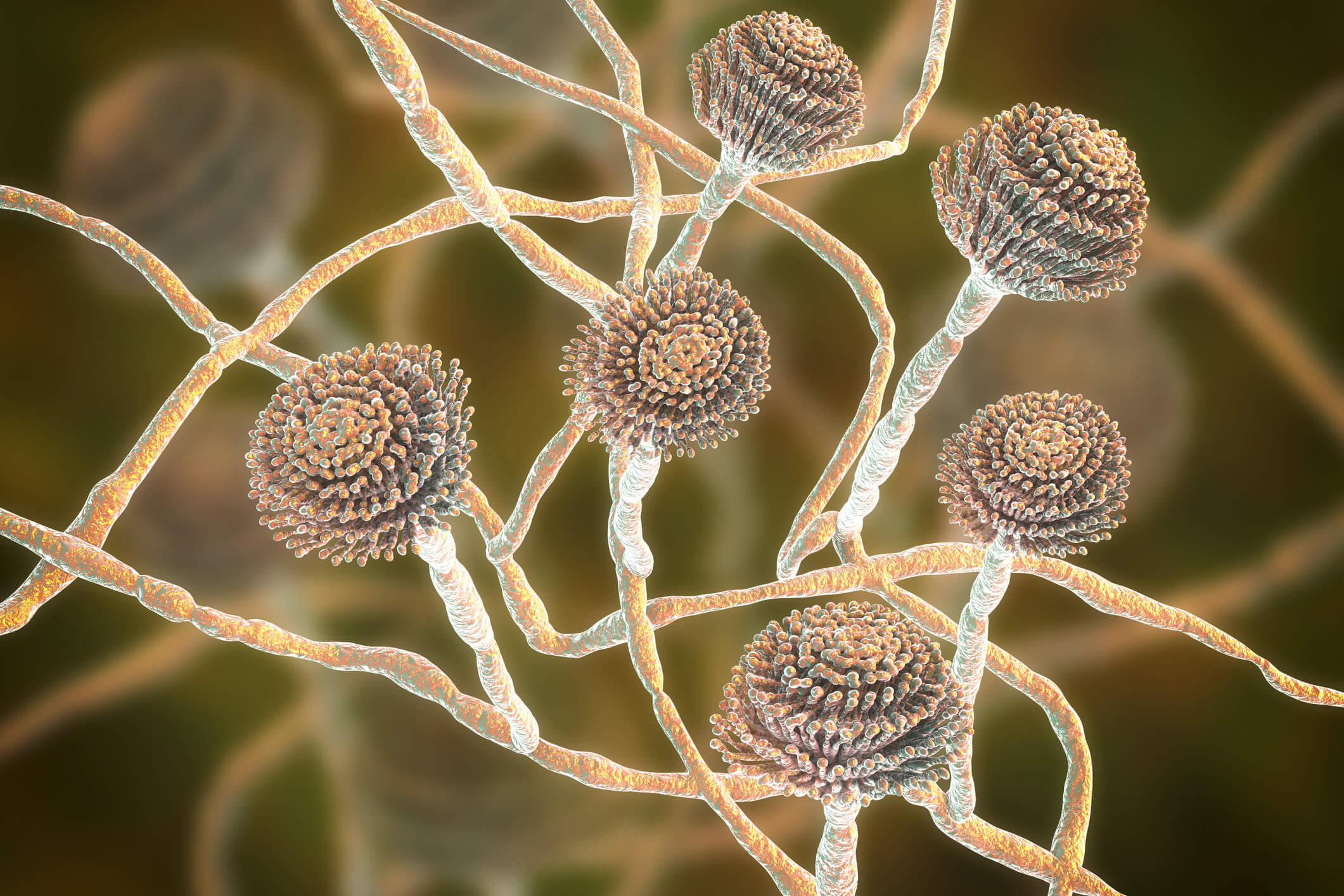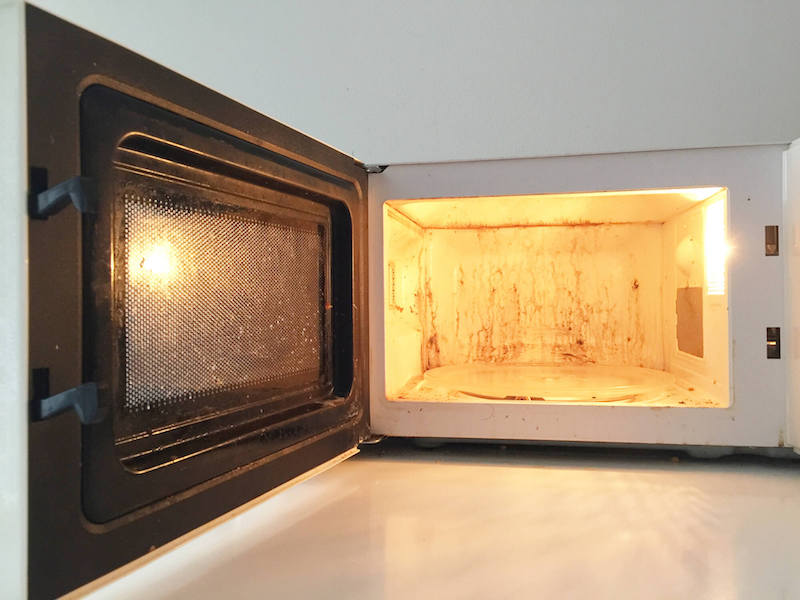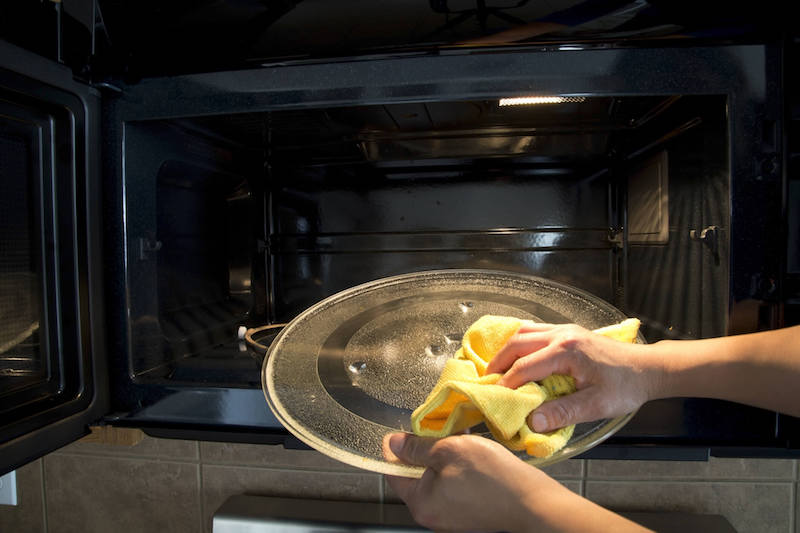No products in the cart.
Microwaves may be one of the best inventions of the 20th century. They’re definitely a worldwide favorite kitchen gadget. Heat or reheat any food or beverage in as little as 60 seconds? And it’s easy to use? Talk about a gold-star member of the household. This technological beauty isn’t all sunshine and rainbows, though. Sometimes they can be kitchen nightmares, especially when they turn into moldy microwaves.

As unfortunate as it sounds, it can happen in the blink of an eye. Sometimes life gets busy and that amazing microwave life-savor starts to become a little funky with ongoing use. A few food particles here and some spilled liquid from reheated soup there, and poof, you’ve got a nice little home for mold. Not to mention a bit of a stinky appliance on your hands, and that’s not including the musty smell mold colonies often create.
In situations such as these, you’ve got to know how to quickly and efficiently take care of this fungal dilemma. Here’s why moldy microwaves are a home health no-no and what to do if this fungus moves in on your favorite kitchen appliance.
A Brief Introduction to Mold
But first, let's talk about mold! You can’t fight off an opponent without knowing who and what they are.
Mold is a type of fungus with over 100,000 species identified so far. Each species reproduces by creating microscopic spores that they release into the air (this is important to remember for later).¹’² Spores will ride the air current to wherever that leads, whether it’s into a tree or right through your front door.
These little particles will remain spores until they land on a surface with the components they need to transition into a growing mold colony. Being the tenacious little fungus that they are, mold spores only need four things to start growing and thriving, which is why moldy microwaves can pop up so quickly and easily.³

These ingredients for life are:
- Oxygen: Mold requires very little, which is why it can grow in walls.
- Temperature: 40-90 degrees Fahrenheit is ideal but some species can live in the extremes.
- Food: They eat pretty much anything, such as dust and organic matter.
- Moisture: This is what’s often missing for them to start living.
If a spore finds a surface with all of these components present for at least 24-48 hours, it will put down roots called hyphae and start to grow. A growing mold colony is a reproducing mold colony.
Mold in the Home
While mold is a crucial part of nature, it’s not a welcome organism to have in the home. Again, once that mold starts to grow, it will begin releasing spores into the surrounding area. Some species of mold can also produce microscopic toxins called mycotoxins when they feel threatened.⁴
With how homes are now built to improve energy efficiency, any spores and toxins created by the mold colony remain trapped within the walls of the home. Not only does that tank the air quality, but it also contaminates the surfaces of everything within the home. These microscopy particles can easily hitch a ride on the air current inside and travel to other areas of the home.
That’s why one mold problem can easily turn into multiple issues throughout the space. A growing number of spores in a home increases the chances that one will stumble on a habitable place and create issues such as moldy microwaves.

Why is there mold in my microwave?
While mold can’t survive just from the microwave machine itself, a dirty microwave offers ample opportunity for a colony to thrive. All these machines need are food particles left behind and either condensation from steam or a spill from something like heated water or soup. If a mold spore slips through the door and finds these conditions, it will think it has won the lottery dream home jackpot.
Once established, the mold colony will start reproducing and can survive on the food and water particles that come its way.
Moldy Microwave Health Implications
It’s impossible to completely avoid mold particles. With over 100,000 species across the planet, those microscopic spores and toxins are all over the place. That’s where the common phrase and misconception "mold is everywhere" comes from.
While these particles are everywhere, they’re dispersed throughout the entire planet, meaning you only encounter a few here and there throughout the day. When you’re living in a home with a mold problem, though, all of those particles remain trapped within those walls. In that situation, you’re not just encountering a few particles, you’re living in a mold globe, being exposed to who knows how many contaminants.
The body’s immune system will attempt to eliminate them as it normally does for a few particles, but it can get overrun and malfunction. A whole army is a much bigger task than a couple of spores and toxins.

This can lead to common symptoms such as:
- Runny nose
- Chronic fatigue
- Neurological issues
- Hair loss
- Digestive problems
- Mood swings
- Respiratory issues
- Coughing
- Brain fog
The tricky thing about mold exposure is that everyone responds differently. Factors such as species of mold, duration of exposure, presence of mycotoxins, genetics, and preexisting conditions all play a role. What researchers do know is that individuals with a developing or compromised immune system are at greater risk of developing symptoms faster and to a greater extent. ⁵‘⁶’⁷’⁸’⁹
Mold exposure can also work in tandem with other autoimmune conditions such as Chronic Fatigue Syndrome, Lyme, and Candida.
Can mold in a microwave make you sick?
Yes. Any exposure to moldy microwaves has the potential to make an individual feel ill. Not only are the particles produced by the colony getting all over any food or beverages that go into the microwave, but they’re also being dispersed into the air.
Since spores and toxins are so small, they can make their way into our lungs. That’s where the health problem arises. The EPA classifies these as particulate matter and groups them into two categories, both of which are inhalable.¹⁰
These two categories are:
- PM10: particles that have a diameter of around 10 micrometers or less.
- PM2.5: fine particles that have a diameter of around 2.5 micrometers or less.
While one person may only develop the occasional runny nose from exposure either from inhalation or ingestion, another may end up suffering from 20. That’s why all moldy microwaves should be dealt with quickly and correctly.
Clearing up the Misconceptions about Moldy Microwaves
There are quite a few misconceptions out there when it comes to mold, particularly about how to remediate it. Here are the answers to all of your questions so you can have an action plan when moldy microwaves strike.
Does a microwave kill mold?
Microwaves can kill some species of mold, but the particles left behind will lead to continued exposure. Dead mold still can trigger adverse health reactions. Not only that but spores and mycotoxins also can lead to health issues.
When it comes to moldy microwaves, turning them on and trying to zap the mold out is not the best cleaning technique.

What if you don’t see mold?
Mold can go undetected for some time by growing in a little corner or within a piece of food. In these instances, there can still be an issue because the colony is still creating contamination. Out of sight, out of mind definitely doesn’t count in this situation.
If you suspect mold in a microwave or are worried, you can use your nose to help unearth a hidden problem. Mold creates a damp, musty, earthy smell, so if you pick up on that, there could be an underlying issue. Also, if you open up the microwave door after some time and there are pooled liquid and food particles inside, it’s best to err on the side of caution and treat the situation as if there’s a visible mold colony inside.
Should you use bleach to clean mold in a microwave?
No, you should not use bleach to get rid of mold.¹¹ While bleach will kill mold on non-porous surfaces, it will leave particles behind. Mold left behind leads to mold exposure. Prolonged exposure means symptoms can continue or get worse.
Moldy microwaves are no joke, especially since we eat the food that comes out of them. In the next episode of things that will make you stay up at night…
How to Clean Mold in a Microwave
Moldy microwaves are super yucky, but luckily they’re fairly easy to handle. Here are remediation steps to kick that mold problem to the curb.
Tools You’ll Need
- White vinegar or Benefect: These are non-toxic, which means they won’t trigger mold to release mycotoxins. They also help lift mold to the surface so it can be removed.
- Protective gear (a mask and gloves): This will help reduce exposure from particles kicked up during removal)
- Microfiber towels: These are 100 times better at removing small particles than regular rags.
- A spray bottle: To place your cleaner in.
Steps to Remediate Moldy Microwaves

- Put on that protective gear
- Place some of the white vinegar or Benefect in a spray bottle
- Remove the turntable if possible
- Thoroughly spray the interior of the microwave with your cleaner, including the inside of the door
- Allow this to sit
- Place the turntable in the sink and spray it with your cleaner. Allow it to sit for a while
- Spray the outside of the machine, allow it to sit for at least 10 seconds, and wipe it down with the microfiber cloth
- Wipe everything down with the microfiber towels, making sure to get into all corners
- Place a microwaveable bowl full of vinegar inside and run the machine for a minute or so
- Wet the microfiber towel and wipe the interior of the machine
- Let the interior completely dry before closing the door
Keep in mind that mycotoxins and bacteria, another contaminant that’s often found with mold, are particularly difficult to remove, so complete the wipe-down process at least three times to make sure all of the harmful particles are gone.
If the mold comes right back, it could indicate a larger issue, such as a hidden mold issue elsewhere in the kitchen. You can remediate again and take a look around the room, such as underneath sinks and cabinets to check, but it’s best to call in a mold inspector to see if there’s a problem. When it comes to indoor mold growth, it's always better to be safe than sorry.
Preventing Moldy Microwaves
The best way to handle moldy microwaves is to prevent them from occurring in the first place! Luckily, avoiding mold in microwaves can be pretty simple.
Here are a few steps to take to prevent moldy microwaves:
- Wiping after use: This removes all of those yummy food particles and water that a mold spore needs to live.
- Regular deep cleaning: Cleaning the machine once a week or so removes hidden food specks as well as gets rid of any mold spores hanging around. You can use the cleaning method above to keep your microwave sparkling clean.
- Maintaining low indoor humidity: The ideal level of indoor humidity is 30–50%, so aim for this.¹² Any higher and it can support mold growth.
- Reduce moisture in the kitchen: Less moisture leads to fewer opportunities for mold spores to grow. Reducing moisture can be accomplished by immediately wiping up spills, turning on the exhaust vents while cooking, fixing any faulty appliances, investing in a dehumidifier, and addressing leaks quickly.
Incorporating the steps above is a great way to prevent moldy microwaves, but don’t feel like you have to jump in and do it all at once. That can lead to feeling overwhelmed. Instead, tackle one project at a time. As long as you’re actively working towards preventing mold, you’re on the right path.
Keeping the Kitchen a Safe Zone

Topics like moldy microwaves probably aren’t at the top of the list for dinner party conversations, but that doesn’t mean they're not important to be aware of. Maintaining a safe home includes preventing health hazards like indoor mold growth. No one wants to eat contaminated food, breath in contaminated air, or hang out with mold.
To keep you and your family safe, knowing the dangers of moldy microwaves, how to handle them, and taking steps to prevent them from occurring in the first place are excellent ways to promote a healthy indoor environment. That way, you can focus on the important things, like popping popcorn for movie night or heating those leftover nachos for a midnight snack.
Health begins at home.™
Citations:
- Environmental Protection Agency. (n.d.). Mold. EPA. Retrieved from https://www.epa.gov/mold.
- Centers for Disease Control and Prevention. Basic facts about mold and dampness. Centers for Disease Control and Prevention. Retrieved from https://www.cdc.gov/mold/faqs.htm.
- Lstiburek, J., Brennan, T., & Yost, N. (2002, January 15). Rr-0208: What you need to know about mold. Building Science Corporation. Retrieved from, https://www.buildingscience.com/documents/reports/rr-0208-what-you-need-to-know-about-mold/view.
- World Health Organization. (n.d.). Mycotoxins. World Health Organization. Retrieved from https://www.who.int/news-room/fact-sheets/detail/mycotoxins.
- Environmental and Occupational Health Assessment Program, & Environmental and Occupational Health Assessment Program, & Health Science Section, Mold Basics for Primary Care Clinicians (2009). Hartford, CT; Connecticut Department of Public Health. , H. S. S., Mold Basics for Primary Care Clinicians 1–10 (2009). Hartford, CT; Connecticut Department of Public Health.
- Curtis, L., Lieberman, A., Stark, M., Rea, W., & Vetter, M. (2004). Adverse health effects of indoor molds. Journal of Nutritional & Environmental Medicine, 14(3), 261-274.
- Bush, R. K., Portnoy, J. M., Saxon, A., Terr, A. I., & Wood, R. A. (2006). The medical effects of mold exposure. Journal of Allergy and Clinical Immunology, 117(2), 326-333
- Fisk, W. J., Lei-Gomez, Q., & Mendell, M. J. (2007). Meta-analyses of the associations of respiratory health effects with dampness and mold in homes. Indoor air, 17(4), 284-296.
- Wild, C. P., & Gong, Y. Y. (2010). Mycotoxins and human disease: a largely ignored global health issue. Carcinogenesis, 31(1), 71-82.
- EPA. (n.d.). Health and Environmental Effects of Particulate Matter (PM). EPA. Retrieved October 8, 2021, from https://www.epa.gov/pm-pollution/health-and-environmental-effects-particulate-matter-pm.
- EPA. (n.d.). Should I use bleach to clean up mold? EPA. Retrieved from https://www.epa.gov/mold/should-i-use-bleach-clean-mold.
- EPA. (n.d.). A Brief Guide to Mold, Moisture, and Your Home. EPA. Retrieved from https://www.epa.gov/mold/brief-guide-mold-moisture-and-your-home#tab-6.
Still Have Questions?
A member of our team is here to help! Click on “Get Started ➤” below to book a consultation with a member of the HOMECLEANSE team. We have a few quick questions that will help us put together a roadmap to solve or prevent all of your mold problems.
Two minutes of your time could lead to better health for you and your family.
